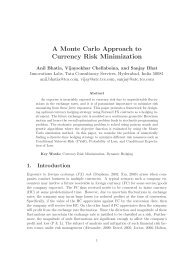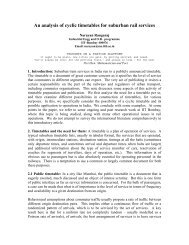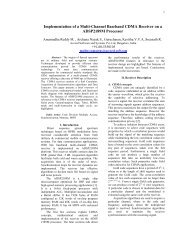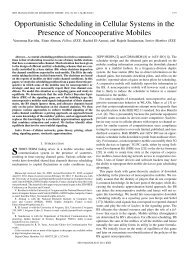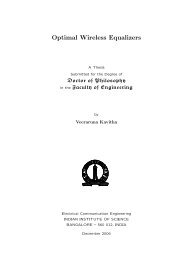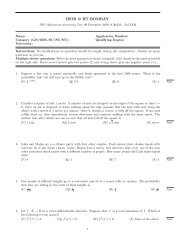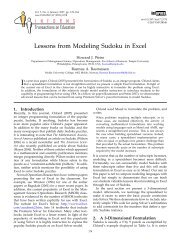PDF Link - Industrial Engineering and Operations Research (IEOR)
PDF Link - Industrial Engineering and Operations Research (IEOR)
PDF Link - Industrial Engineering and Operations Research (IEOR)
- No tags were found...
Create successful ePaper yourself
Turn your PDF publications into a flip-book with our unique Google optimized e-Paper software.
terminals. The former is obviously the prefered (but more expensive) model for door-todooreffectiveness in h<strong>and</strong>ling.From the transporter’s perspective, the multimodal nature of movement invariablymeans that multiple agencies are involved in the activity, one way or another. Anadditional activity is the provisioning of containers themselves, <strong>and</strong> providing forfacilities at which containers can be stored <strong>and</strong> h<strong>and</strong>led. Apart from this, multimodalmovement implies co-ordination across the various agencies, such as freight forwarders,truckers, container stations, sometimes rail, ports, shipping lines, etc. There is often aninfrastructural element in these activities, which have sometimes to be facilitated orprovided by government or other agencies with long time horizon plans in place.Given that this can be quite a challenging task to plan for, we attempt to outlinesome specifics of such multimodal movements, in a particular case of containerisedimport <strong>and</strong> export traffic to <strong>and</strong> from India. The objectives of this paper are:(a) to highlight the role of some of the major players in the business ofmultimodal transport <strong>and</strong> to discuss the accompanying issues in logisticsmanagement(b) to describe one such supply chain involving multimodal movement ofcontainers <strong>and</strong> to identify how various initiatives by organisations haveresulted in supply chain effectiveness.Rangaraj <strong>and</strong> Viswanadham (2001) provides a more detailed discussion of these.PART 11. Multimodal transport: The concept of multimodal transport has been comparativelyslow to get started in India. Containerisation is not yet the major mode of transport, <strong>and</strong>on the roads, open truck movements are quite common. Srivastava <strong>and</strong> Khanna (2001),Ravi Babu (2001) <strong>and</strong> [4] provide a quick, comparative study of developments inmultimodal transport, with special reference to India.Another dimension to the management of multimodal transport activity is that it isdifficult to set norms <strong>and</strong> design systems that are easily accepted. This is because thereare a number of actors <strong>and</strong> there are natural conflicts of firm level economic interest thatare not easy to resolve. For example, the aggregation efficiency that determines onefirm’s cost effectiveness could lead to overall delays <strong>and</strong> inventory costs in another firmsperformance, all as part of the same supply chain. This is quite typical in an integratedsupply chain management environment context, where multi actor co-operation isrequired. A framework for benchmarking multimodal transport activity has beenattempted by Ockwell [3].2. Flows of containerised traffic: The movements of goods by the containerised modehas increased in India over the last few years. This has happened both in theimport/export as well as the internal movement sector. For example, the movement ofgoods through major ports has shown the following indicative trend. The most importantport that h<strong>and</strong>les containerised traffic in India is Jawaharlal Nehru Port Trust (JNPT) <strong>and</strong>the associated Nhava Sheva Inl<strong>and</strong> Container Terminal (NSICT). Traffic h<strong>and</strong>led herehas grown from 11.723 million tonnes in 1998-1999, to 18.573 million tonnes in 2000-



